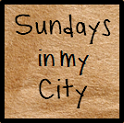I was wondering whether the
narcissi were in bloom yet this season and decided to look online for a new place to find them. I stumbled upon the Shoham Forest Park quite by chance. Shoham is very close by and seemed like the perfect place to go and see flowers on a recent sunny winter's day.
The Shoham Forest (or the Shoham Forest Park) is a relatively young forest, located east of the town of
Shoham, southeast of Tel Aviv. The rocky forest is rich in heritage sites, the most impressive of which is the Church of St. Bacchus with its recently exposed, magnificent mosaic floor. In the winter and spring, the forest is abundant with seasonal flowers.
The ancient church of St. Bacchus was discovered in 1986 while planting trees. The mosaic was covered until 2013, and was only recently exposed to the general public. This church is considered a "field church" - a church that was not located in a settlement but in an open area between communities. Surprisingly, a marble medallion 67cm in diameter of the Greek goddess
Tyche, or as she is called in Latin 'Fortuna', was discovered in the church - an idolatrous element that is not accepted in Christian churches. Tyche is the pagan goddess of fortune and fate, as well as the goddess that protects cities. Finding such an artifact in a church is exceptional. The marble medallion shows the goddess surrounded by two inscriptions. The bottom inscription makes is possible to date it to the year 582-3 CE. The marble medallion is now on display at the Israel Museum in Jerusalem.
At the bottom of the steps of the church is an inscription dedicated to St. Bacchus. St. Bacchus may have been a local saint, or one of two Christian martyrs from Syria (
Sergius and Bacchus) who converted to Christianity in the third century and were executed by order of
Emperor Diocletian.
The floor of the church is a mosaic that combines geometric patterns and floral motifs. In the
nave of the church two circles are depicted: the centre of the eastern circle is the exact centre of the church. In the middle of the western circle is the Greek inscription "This place belongs to the Lord and his only son".
A stone quarry that served as an ancient water reservoir is located north of the church, and south of the church is a lime kiln and an ancient wine press. On the western side of the church is an ancient olive press, above. Olive oil was produced in the press by the means of two installations: an olive crushing installation composed of a crushing basin and crushing stone, and a press consisting of a large wooden beam, screws and weights, a collecting vat, and a niche for baskets used to hold the olive mash. The olives brought to the press were mashed in the crushing installation and from there were transferred to baskets to be pressed in this unique installation.


In 2014, a model of the
Madaba map was added to the site, above. The Madaba map is part of mosaic floor from the Byzantine period that was discovered in a 19th century church in the city of Madaba, Jordan. The Madaba map is a map of the Middle East. Part of it contains the oldest surviving original cartographic depiction of the Holy Land and especially Jerusalem. It dates to the 6th century AD. The map of Madaba mentions a settlement called "Beit Malgazis", which the archaeologists identify as Horvat Tinshemet ("Barn Owl Ruins"), where the remains of the Byzantine church of Bacchus were exposed. Other settlements mentioned on the map are
Hadid (or "Iditim" on the map) and
Modi'in.





From the church we set off for a walk along the marked trail. It passed through the southern part of the Shoham Forest and the "Hill of Cup marks" where a lookout point is located in memory of a soldier who fell in battle in Lebanon in 1994. The name of the hill comes from a large rock located there which has various sized depressions carved into it. The small depressions are known as "
cup marks" and may have been formed by cracking nutshells, and the larger ones were used to crush grains and herbs. The view from the lookout point is impressive, extending westward toward the coastal plain and eastward towards the
Samaria mountains.
Returning to the main path we continued on, passing orchard trees and rocky areas. Shoham Forest Park itself is quite small. Remains of settlements from the
Mishnaic period and a number of ancient caves were discovered in areas of the park. The
Israel National Trail, a hiking path that crosses the entire country, crosses the park from north to south in its western part. Our own walk was a gentle one, suitable for the whole family, and was a lovely way spend a sunny afternoon.





















































































